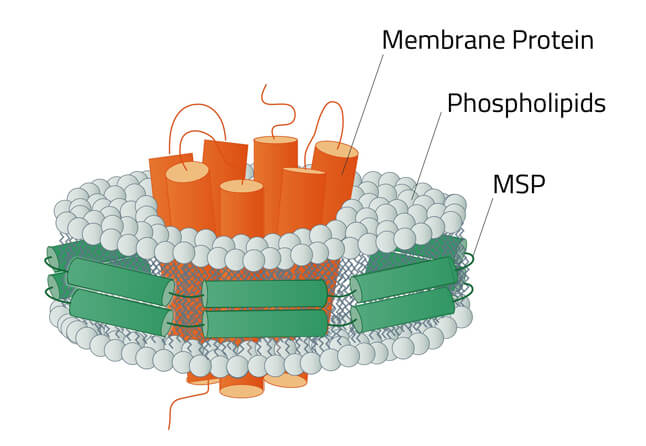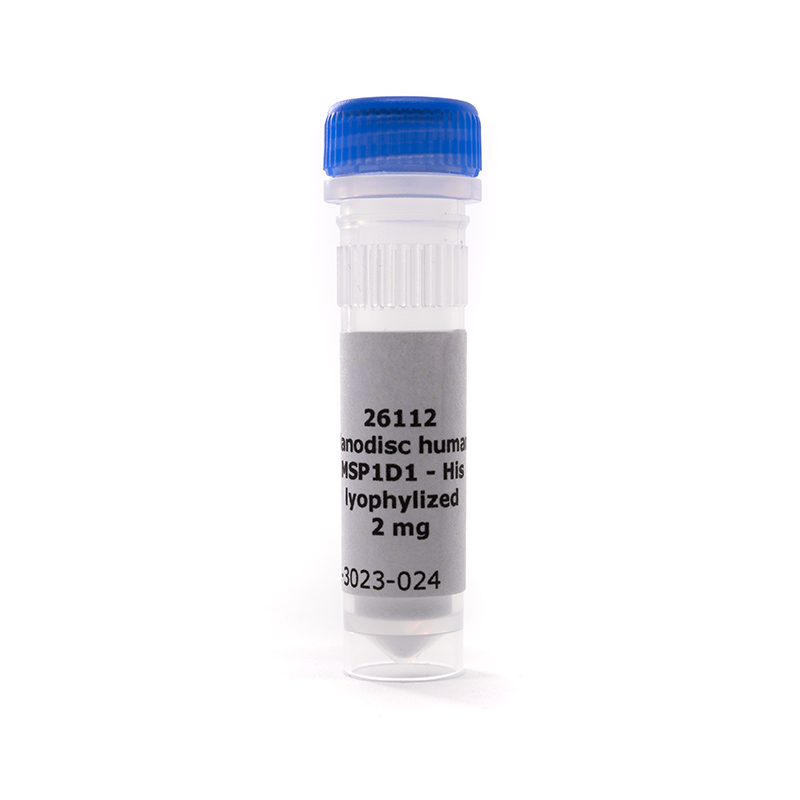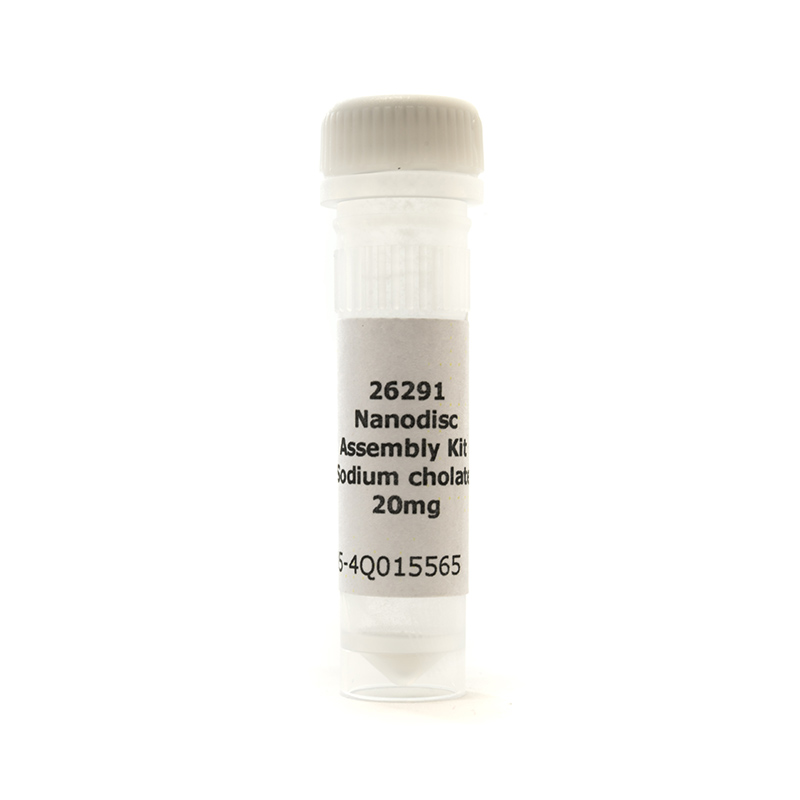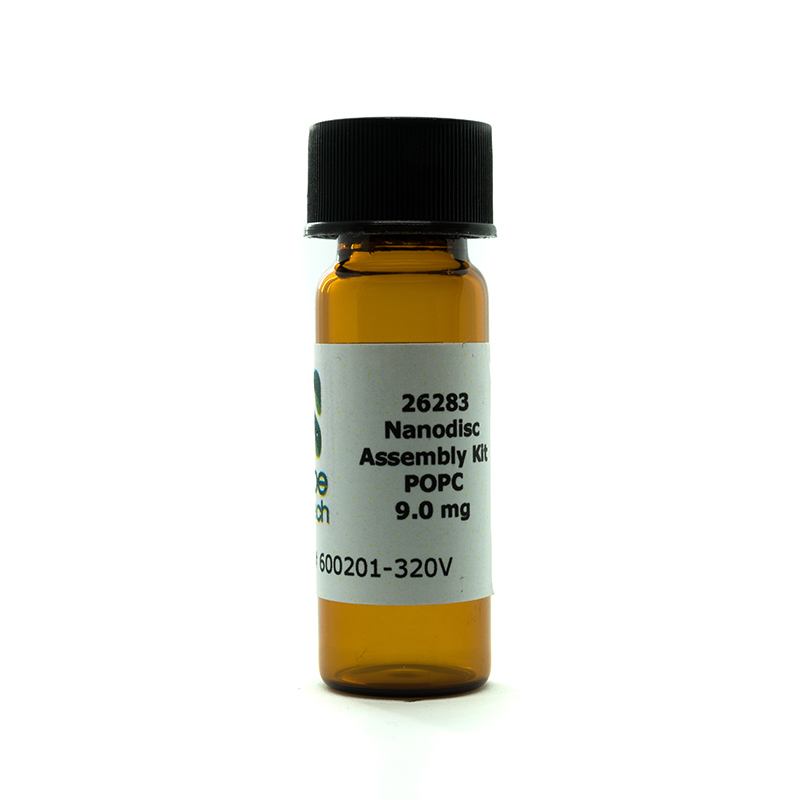Nanodisc Assembly Kit MSP1D1-His POPC
Order number: 26213
Description
Membrane scaffold proteins derive from apolipoprotein (apo; A-I). They are used in membrane protein sciences to stabilize membrane proteins in a lipid environment after the removal of the cell membrane. The size of the nanodisc is determined by the MSP that was used to create the disc. MSP1D1 (His-tagged) creates nanodiscs of ~9-10 nm in diameter.
This product is a MSP nanodisc assembly kit. It contains a vial of lyophilized membrane scaffold protein MSP1D1 (His-tagged) and a vial of DMPC or POPC phopshospholipid to assemble a MSP nanodisc.
With this assembly kit both cellular as well as cell-free expressed proteins can be stabilized in MSP nanodiscs. Just use the corresponding protocol for each purpose (see below). The MSP protein contains a His-tag, keep that in mind when choosing the affinity tag for your membrane protein.
Other MSP products or related sites by Cube Biotech include:
This product is a MSP nanodisc assembly kit. It contains a vial of lyophilized membrane scaffold protein MSP1D1 (His-tagged) and a vial of DMPC or POPC phopshospholipid to assemble a MSP nanodisc.
With this assembly kit both cellular as well as cell-free expressed proteins can be stabilized in MSP nanodiscs. Just use the corresponding protocol for each purpose (see below). The MSP protein contains a His-tag, keep that in mind when choosing the affinity tag for your membrane protein.
Other MSP products or related sites by Cube Biotech include:

Datasheets
- Download MSP Assembly Kit MSP1D1 (His-tagged) POPC Datasheet
- Download MSP Assembly Kit MSP1D1 (His-tagged) DMPC Protocol
- Download MSP Assembly Kit MSP1D1 (His-tagged) DMPC Cell-free Protocol
- Download MSP Assembly Kit MSP1D1 (His-tagged) POPC Protocol
- Download MSP Assembly Kit MSP1D1 (His-tagged) POPC Cell-free Protocol
| Feature - MSP Protein | |
|---|---|
| Purity | > 90% (Determined by SDS-PAGE) |
| Number of amino acids | 217 |
| Molecular Mass | 25,309 Da |
| Extinction coefficient (in water) ε280 | 25,440 M-1cm-1 |
| Buffer | 20 mM TRIS pH 7.4; 100 mM NaCl; 0.5 mM EDTA |
| Sequence (Human origin), for the other origins please send request | MGSSHHHHHH ENLYFQ GLKLLDNWDSVTSTFSKLREQLG PVTQEFWDNLE KETEGLRQEMS KDLEEVKAKVQ PYLDDFQKKWQEEMELYRQKVE PLRAELQEGARQKLHELQEKLS PLGEEMRDRARAHVDALRTHLA PYSDELRQRLAARLEALKENGG ARLAEYHAKATEHLSTLSEKAK PALEDLRQGLL PVLESFK VSFLSALEEY TKKLNTQ |
| Affinity tag | N-Terminal His-tag |
| Shipping Temperature | Room Temperature |
| Storage of lyophilized protein | -20°C for several months |
| Storage of reconstituted protein | 2-8°C for several days |
| Helpful literature references |
|
| Feature - Phospholipids | |
|---|---|
| CAS-Number |
|
| Molecular Mass |
|
| Chemical Formula |
|
Video
Watch our video tutorial about the creation of MSP nanodiscs. It explains the whole process, starting with the initial solubilzation using detergents. The protein that was stabilized in this demonstration was Bacteriorhodopsin.
We also recommend our video guide to nanodiscs in general.
We also recommend our video guide to nanodiscs in general.
FAQ
Can I get the datasheet for the MSP1D1 (His-tagged) nanodisc assembly Kits?
Yes. Just download them here.
Is this the correct MSP product for my membrane protein?
This cannot be answered easily as every membrane protein performs differently with each nanodisc size and phospholipid. It usually requires a screening process before. Remember that membrane proteins with fewer transmembrane domains (TMD) require a smaller nanodisc, while a high number of TMDs need a larger nanodisc.
Can I shorten the cell-free stabilization protocol?
In a way. You can use our already pre-assembled MSP nanodiscs to skip the actual time consuming assembly of the nanodisc.
MSP nanodiscs require solubilization with detergents in before. Do you also offer these?
Yes, we do. Just have a look at them here.
I have never worked with MSP nanodiscs before. Can you tell me more about them?
Of course! In fact we created this MSP Nanodisc Guide Page, for this purpose. Have a look at it!
Are there other options to stabilize membrane proteins besides MSP nanodiscs?
Yes, there are. We recommend synthetic copolmer nanodiscs greatly! Have a look at our Guide Page to learn more.
Disclaimer
Our products are intended for molecular biology applications. These products are not intended for the
diagnosis, prevention, or treatment of a disease.
Nanodiscs are protected by US Patents 7,691,414; 7,662,410; 7,622,437; 7,592,008; 7,575,763; 7,083,958; 7,048,949
Nanodiscs are protected by US Patents 7,691,414; 7,662,410; 7,622,437; 7,592,008; 7,575,763; 7,083,958; 7,048,949





